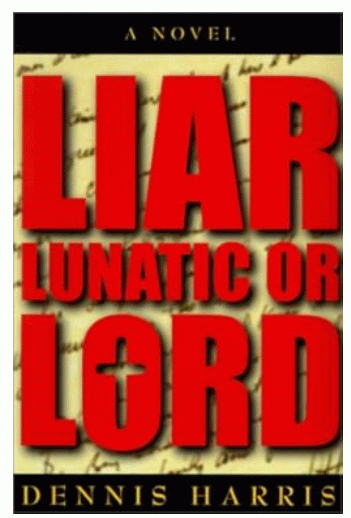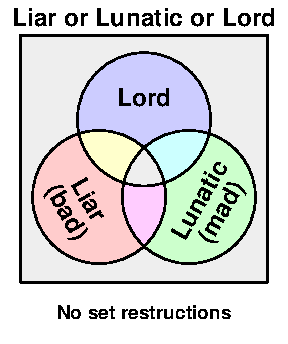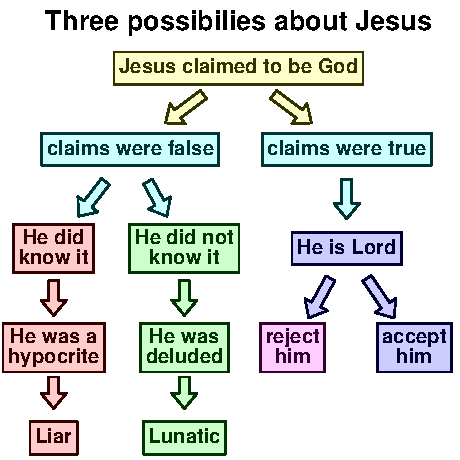Send
Close Add comments:
(status displays here)
Got it! This site "creationpie.org" uses cookies. You consent to this by clicking on "Got it!" or by continuing to use this website. Note: This appears on each machine/browser from which this site is accessed.
Trilemma: liar or lunatic or Lord
1. Trilemma: liar or lunatic or Lord
 |
 |
 |
438 pages
|
110 pages
|
160 pages
|
The
liar (bad or evil) or
lunatic (mad) or
Lord argument was made popular by C. S. Lewis when he used the argument on a radio broadcast to argue for the divinity of Christ.
The basic claim, however, goes back further in time. The argument is sometimes called the
trilemma. The argument was later used by Josh McDowell on college campuses where it became even more well known. Is the logic valid?
Note that if the logic is invalid, it does not mean that the claim is not true. It just means that this argument is not valid in showing the conclusion.
Some try to avoid the argument by asserting that Jesus never claimed to be Lord.
2. Disjunction
The
trilemma, or "
Liar, lunatic or Lord" argument is a
disjunction of three arguments:
Liar or Lunatic or Lord
To
evaluate a disjunction (or any expression), one needs to
pick an
order in which to evaluate.
A disjunction is
commutative in that it does not depend on the order of evaluation of the arguments.
3. C.S. Lewis
The liar (bad or evil) or lunatic (mad) or Lord argument originated with C. S. Lewis on a radio broadcast for the BBC during World War 2 to argue for the divinity of Christ. These broadcasts were later consolidated into the book
Mere Christianity.
This argument in his book
Mere Christianity and stated that "
Jesus Christ was either a liar, a lunatic, or the Son of God, and that we cannot dismiss him as merely a great moral teacher".
In natural language, the "or" or "disjunction" is taken to be the exclusive or as in "A or B but not both".
In logic, the "or" or "disjunction" is taken to be the inclusive or as in "A or B or both".
Analysis of the argument here starts at the logical
inclusive or and then, if needed, to the
exclusive or.
4. John Duncan
Wikipedia (as of 2025-03-29): John Duncan (1796-1870) stated the following.
Christ either deceived mankind by conscious fraud, or He was Himself deluded and self-deceived, or He was Divine. There is no getting out of this trilemma. It is inexorable.
Knight, William (1870). Colloquia Peripatetica. p. 109. Knight explains that the conversations quoted took place during the summers of 1859 and 1860.
5. Math proof analogy
Many Christian apologists take the point of view that knocking down every other possible theory will leave their theory standing and valid.
In math, one proves a result using as simple a proof as possible. One does not add hundreds or thousands of paging covering every possible invalid proof.
It is hard to find any Christian apologists that use a simple proof method for the (reality) truth of the Bible.
6. Simple proof method
Here is a simple proof method for the (reality) truth of the Bible.
1. Coded information argument: Coded information cannot arise by chance. Thus, there must be a creator outside of time and space (as we know it).
2. If the Creator sent us a message, there should be authentication codes in that message to validate that message as authentic.
It helps to have a good understanding of information theory, error correcting codes, fault tolerance, security theory, etc.
Many ways that Christian apologists attempt to show the truth of the Bible are flawed.
7. Colors and color models
Two simple models are the
RGB and
CMYK color models. Each model is correct. One way may be easier to work with for certain purposes.
8. Step 1
The
logic of the
trilemma is now
abstracted using colors.
There are many colors in reality.
In the light color model, using eight colors, the three primary colors are
red,
green and
blue.The other colors are
cyan,
magenta,
yellow,
white and
black.
We will now prove that Jesus is
blue. To see the logic without delays, one should, at each step, agree to what is said. One can then question the assumptions at the review.
9. Step 2
You can believe me that there are only three colors of concern:
red,
green and
blue, and combinations thereof. That is, they are
collectively exhaustive.
10. Step 3
You can believe me that the only colors that matter are
red,
green and
blue. There is no overlap. That is, they are
mutually exclusive.
11. Step 4
You can now prove to yourself that Jesus is
blue.
You can believe me that Jesus is not red.
You can believe me that Jesus is not green.
The only choice left is blue.
You have now proved to yourself that Jesus is blue.
Can you see anything in this logical argument that may cause you to question the logic?
12. Build review
Note that you can reject the logic for a conclusion as invalid while still accepting the conclusion.
One then needs to find a valid logical argument that leads to the conclusion.
13. Logical fallacies
Many logical fallacies can be viewed from multiple perspectives.
A false dilemma presents one with alternatives that are either not complete or lacking in some respect.
The converse error takes an implication and turns it around in a way that is not valid. The converse error is equivalent to the fact check fallacy.
The begging the question fallacy, from Aristotle, is that of in some way assuming the conclusion in the premises.
Note that the logical argument can be invalid in one or many ways but the conclusion may be true.
That is, disproving the proof does not mean that what is claimed to be proven is actually not true.
14. Error codes
Many logical fallacies can be viewed from multiple perspectives. This idea is reflected in computer programming in the returning of error codes from a process, routine, etc.
In general,
0 represents
false and
1 represents
true. However, there is, in general, only one way for something to work while there are many ways for it to not work. Thus, the following convention is often used for returning error codes.
Code 0 means it worked.
Code 1 is error number 1.
Code 2 is error number 2.
... and so on ...
In computer code, the first error detected is returned. The code never gets to other possible errors. In the same manner, any logical reasoning that is not valid can have many possible error codes. When more information needs to be returned in computer code, a set (or list) representation might be used.
15. Trilemma alternatives
Consider the alternatives for the liar or lunatic or Lord trilemma.
Are they collectively exhaustive (include all alternatives)?
Are they mutually exclusive (do not overlap)?
Are they both collectively exhaustive and mutually exclusive?
How many of liar, lunatic or Lord are dependent on viewpoint?
16. False dilemma fallacy: excluded middle
A "
false dilemma" is a logical fallacy whereby only a few of all possible choices are presented as being "
collectively exhaustive". In some cases, the choices presented are not "
mutually exclusive".
This fallacy is sometimes called the fallacy of "
excluded middle". Another name is that of "
false dichotomy" though the fallacy can involve more than two choices as in the trilemma: liar, lunatic or Lord.
17. Trilemma alternatives
How many of
liar or
lunatic or
Lord are dependent on viewpoint? Do those assumptions
assuming the conclusion?
Discuss:
Identify the lunatic or lunatics in the TV show Green Acres.
How does one determine a lie?
Do there people who would consider themselves Lord (e.g., King, dictator, etc.) who meet the following criteria?
They never lie. Do they lie (in some way)?
They are sane (not mad). Could they be considered a lunatic (in some way)?
18. Fabricating Jesus: Alternative trilemma alternatives
In his book
Fabricating Jesus, author Craig Evans
assumes the sets for "
Liar, lunatic or Lord" are
mutually exclusive and calls it an
excluded middle fallacy. In a logical analysis, one should
not jump to that conclusion until further in the general analysis.
He then presents his view (opinion) that "
Lord" is
not a viable alternative and presents his opinion on other alternatives outside of the domain of "
Liar, lunatic or Lord".
19. Trilemma deductive reasoning
Deductive reasoning is
top-down from assumptions. For invalid reasoning, these assumptions may not hold.
Some try to avoid or side-step the argument by asserting that Jesus never claimed to be Lord.
20. Inductive or deductive
 |
 |
declarative - inductive
bottom-up
|
imperative - deductive
top-down
|
To
evaluate a disjunction (or any expression), one needs to
pick an
order in which to evaluate.
As one goes from
inductive (some call it
abductive) to
deductive reasoning, the assumptions in the deductive reasoning become important. This can involve the following.
"Assuming the conclusion", called "begging the question".
This can involve "circular reasoning" as a general concept.
Some try to avoid or side-step the argument by asserting that Jesus never claimed to be Lord.
[abductive reasoning]
21. Aristotle: Circular reasoning
English: Circular or reciprocal proof consists in using the conclusion and the simple conversion of one premise to demonstrate the remaining premises, which was assumed in the original syllogism. (Loeb#325, p. 437)
Greek: Τὸ δὲ κύκλῳ καὶ ἐξ ἀλλήλων δείκνυσθαί ἐστι τὸ διὰ τοῦ συμπεράσματος καὶ τοῦ ἀνάπαλιν τῇ κατηγορίᾳ τὴν ἑτέραν λαβόντα πρότασιν συμπεράνασθαι τὴν λοιπήν, ἣν ἐλάμβανεν ἐν θατέρῳ συλλογισμῷ. Aristotle: Prior Analytics [57b]
In the 1960's the speed of light was redefined to be based on certain atomic measurements. These measurements are themselves based on the speed of light.
Recursive: referring to itself. See recursive.
So, using
circular reasoning, the speed of light is defined in terms of the speed of light such that it never changes. This is like using a "
rubber ruler" that can adapt to whatever it is that one is measuring.
22. Aristotle: Begging the question
English: Begging or assuming the point at issue consists (to take the expression in its widest sense) in failing to demonstrate the required proposition. (Loeb#325,485)
Greek: Τὸ δ' ἐν ἀρχῇ αἰτεῖσθαι καὶ λαμβάνειν ἐστὶ μέν, ὡς ἐν γένει λαβεῖν, ἐν τῷ μὴ ἀποδεικνύναι τὸ προκείμενον, … Aristotle: Prior Analytics [64b]
The Latin word
"petitio principii" ≈ "an assumption from the beginning" comes from the ancient Greek word
"ἐν ἀρχῇ αἰτεῖσθαι" ≈ "in the beginning take as an assumption".
This is called
"begging the question" from an inaccurate translation of
"assuming the initial point" and then a change in meaning of "
beg" as in "
raise a question". In modern English, the meaning of
"begging the question" has
changed to that of "
avoid the question" or "
evade the issue".
23. 1 Timothy 4:8 Exercise restraint
 1 Timothy 4:8 For bodily exercise profiteth little: but godliness is profitable unto all things, having promise of the life that now is, and of that which is to come. [kjv]
1 Timothy 4:8 For bodily exercise profiteth little: but godliness is profitable unto all things, having promise of the life that now is, and of that which is to come. [kjv]
 η γαρ σωματικη γυμνασια προς ολιγον εστιν ωφελιμος η δε ευσεβεια προς παντα ωφελιμος εστιν επαγγελιαν εχουσα ζωης της νυν και της μελλουσης [gnt]
η γαρ σωματικη γυμνασια προς ολιγον εστιν ωφελιμος η δε ευσεβεια προς παντα ωφελιμος εστιν επαγγελιαν εχουσα ζωης της νυν και της μελλουσης [gnt]
Is "
bodily" "
exercise" "
profitable"? What is the
objective function? None is provided but one might be inferred.
Is "
godliness" "
profitable"? What is the
objective function? This is added at the end as a "
promise".
The reasoning is similar to that attributed to Aristotle and pointed out as a deception of "
begging the question" or "
assuming the conclusion". In the case of this verse, what Paul (the assumed writer) is claiming is "
begging the question" in that he is assuming an objective function (for the latter claim) and then using it to support the claim of "
profitable". Logically, then, this verse does not really say anything important.
24. Diagram: Liar, Lunatic, Lord
Here is one diagram, representative of many, that claims to show the logic.
Some try to avoid or side-step the argument by asserting that Jesus never claimed to be Lord.
Note the "
begging the question" or "
assuming the conclusion" in the logic. The main questions is the following.
What are the specific claims of Jesus and, more generally, the Bible?
How does one determine if they are true?
How does one define truth?
25. Viewpoint consideration
Consider the viewpoints.
How would Christians who already take Jesus as Lord view the alternatives?
How would atheists and those who do not believe the Bible view the alternatives?
26. End of page





